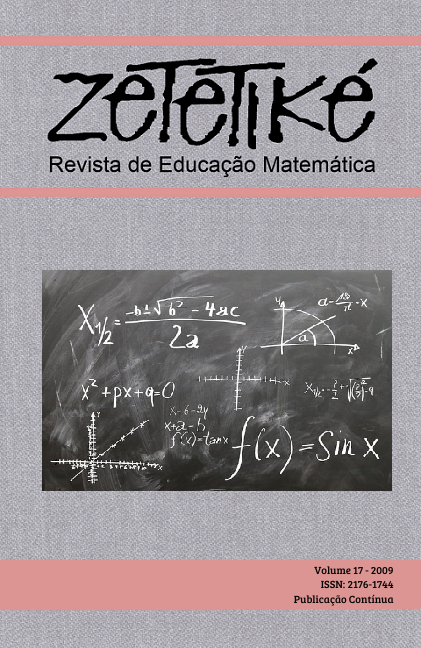Abstract
This article aims to give the teacher a different perspective about a
resource that is daily used in the teaching and learning of concepts: the
examples.
To the existent bibliography about the teaching and learning of mathematical
concepts we wanted to add, in the particular subject of the concept of function,
two aspects arisen from a new line of investigation, the exemplification of
mathematical concepts. These are transparency and variation and we are able to
find them in the examples used in a mathematics classroom. Every example, or
example collections, we use incorporate these two aspects sometimes in a
mechanical and unintentional way. However, if we realise the importance of the
role played by transparency and variation, they both could maximize the
exemplification effectiveness when teaching mathematical concepts.
References
ADAMS, R. Multiple-choice item writing: art and science. The Bar Examiner, v. 61, n. 1, p. 5-14, 1992.
BILLS, L.; DREYFUS, T.; MASON, J.; TSAMIR, P.; WATSON, A.; ZASLAVSKY, O. Exemplification in Mathematics education. In: NOVOTNA, J. (Ed.). Proceedings of the 30th Conference of the International Group for the Psychology of Mathematics Education. Prague, Czech Republic: PME, 2006.
COHEN, R. J.; SWERDLIK, M. E. Psychological testing and assessment: an introduction to tests and measurement. 4 th. ed. Mountain View, CA: Mayfield, 1999.
DAHLBERG, R., HOUSMAN, D. Facilitating learning events through example generation. Educational Studies in Mathematics, n. 33, p. 283- 299, 1997.
FIGUEIREDO, C. A.; BLANCO, L. J.; CONTRERAS, L. C. A exemplificação do conceito de função em quatro professores estagiários. Revista Unión, n. 8, p. 23-39, 2006.
FIGUEIREDO, C. A. Os exemplos utilizados por professores estagiários quando ensinam o conceito de função. Memoria de proyecto de investigación de Doctorado. Departamento de Didáctica de las Ciencias Experimentales y de las Matemáticas, Universidad de Extremadura, España, 2005.
FRARY, R. B. More multiple-choice item writing do’s and don’ts. ERIC/AE Digest, 1995.
GOLDENBERG, P.; MASON, J. Sheding light on and with example spaces. Educational Studies in Mathematics, n. 69, p. 183-194, 2008.
HALADYNA, T. M.; DOWNING, S. M. A taxonomy of multiple-choice item writing rules. Applied Measurement in Education, n. 2, p. 37-50, 1989a.
HALADYNA, T. M.; DOWNING S. M. Validity of a taxonomy of multiplechoice item writing rules. Applied Measurement in Education, n. 2, p. 51- 78, 1989b.
HALADYNA, T. M.; DOWNING S. M.; RODRIGUEZ M. A review of multiple-choice item writing guidelines for classroom assessment. Applied Measurement In Education, v. 15, n. 3, p. 309-334, 2002.
HAZZAN, O.; ZAZKIS, R. Constructing knowledge by constructing examples for mathematical concepts. In: PEHKONEN, E. (Ed.). Proceedings of the 21st Conference of the International Group for the Psychology of Mathematics Education, Lahti, Finland, 1997. v. 4. p. 299- 306.
KEHOE, J. Writing multiple-choice test items. ERIC/AE Digest, 1995.
MARTON, F.; BOOTH, S. Learning and awareness. Hillsdale, USA: Lawrence Erlbaum, 1997.
MASON, J., PIMM, D. Generic examples: seeing the general in the particular. Educational Studies in Mathematics, n. 15, p. 227-289, 1984.
MASON, J. What is exemplified in Mathematics classrooms? 2005. (Não publicado). Disponível em: http://mcs.open.ac.uk/jhm3/OtherPapers/Mason%202005%20What%20is%20Eg%27d.pdf. Acesso em: maio 2006.
MASON, J.; WATSON, A. Mathematical exercises: what is exercised, what is attended to, and how does the structure of the exercises influence these?. In: EARLI BIENNIAL CONFERENCE, 23rd-27th, August, Nicosia, Cyprus. Invited presentation to SIG on variation and attention. Nicosia, Cyprus, 2005.
NIEMI, D. Assessing conceptual understanding in Mathematics: representation, problem solution, justification, and explanation. The Journal of Educational Research, v. 89, n. 6, p. 351-363, 1996.
RISSLAND-MICHENER, E. Understanding Mathematics. Cognitive Science, n. 2, p. 361-383, 1978.
ROWLAND, T.; THWAITES, A.; HUCKSTEP, P. Elementary teachers' Mathematics content knowledge and choice of examples. In: CONFERENCE OF THE EUROPEAN SOCIETY FOR RESEARCH IN MATHEMATICS EDUCATION — CERME, 3th, March, 2003, Bellaria, Italy. Bellaria, 2003.
ROWLAND, T.; ZASLAVSKY, O. Pedagogical example-spaces. In: MINICONFERENCE ON EXEMPLIFICATION IN MATHEMATICS, June, 2005, Oxford University. Notes.
SANGUIN, C. Questions spaces. 2004. (Não publicado). Disponível em: http://mcs.open.ac.uk/jhm3/OtherPapers/ChrisSQuestionSpaces 04.pdf. Acesso em: jul. 2006.
SIRECI, S. G.; WILEY, A.; KELLER, L. A. An empirical evaluation of selected multiple-choice item writing guidelines. In: ANNUAL MEETING OF THE NORTH-EASTERN EDUCATIONAL RESEARCH ASSOCIATION, 1998. Paper. p. 3-17.
VACC, N.; LOESCH, L.; LUBIK R. Writing multiple-choice test items. In: WALZ, G. R.; BLEUER, J. C. (Ed.). Assessment issues and challenges for de millennium. Greensboro, NC: CAPS Publications, 2001. p. 215-222.
WATSON, A.; MASON, J. extending example spaces as a learning/teaching strategy in Mathematics. In: COCKBURN, A.; NARDI, E. (Ed.) Proceedings of PME 26, University of East Anglia, 2002. v. 4. p. 377-385.
WATSON, A.; MASON, J. Mathematics as a constructive activity: learners generating examples. Mahwah, NJ: Lawrence Erlbaum Associates, 2005.
WATSON, A.; SHIPMAN, S. Using learner generated examples to introduce new concepts. Educational Studies in Mathematics, n. 69, p. 97-109, 2008.
ZASLAVSKY, O.; RON G. Students’ understanding of the role of counterexamples. In: OLIVIER, A.; NEWSTEAD, K. (Ed.). Proceedings of PME22. Stellenbosch, South Africa: University of Stellenbosch, 1998. v. 4. p. 225-232.
ZASLAVSKY, O. Open-ended tasks as a trigger for Mathematics teachers’ professional development. For the Learning of Mathematics, v. 15, n. 3, p. 15-20, 1995.
ZAZKIS, R. From Arithmetic to Algebra via big numbers. In: CHICK, H.; STACEY, K.; VINCENT, J.; VINCENT, J. (Ed.). Proceedings of the 12th ICMI Study Conference: the future of the teaching and learning of Algebra. Melbourne, Australia: University of Melbourne, 2001. p. 676- 681.
ZODIK, I.; ZASLAVSKY, O. Exemplification in the mathematics classroom: what is it like and what does it imply? In: CONFERENCE OF THE EUROPEAN SOCIETY FOR RESEARCH IN MATHEMATICS EDUCATION — CERME —, 5th., 2007, Larnaka, Cyprus. Paper. p. 2024- 2033.

This work is licensed under a Creative Commons Attribution-NonCommercial-NoDerivatives 4.0 International License.
Copyright (c) 2014 Zetetiké: Revista de Educação Matemática

